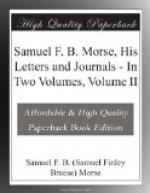Reference was made by Morse, in the letter to Mr. Smith of March 2, to Daguerre and his wonderful discovery. Having himself experimented along the same lines many years before, he was, naturally, much interested and sought the acquaintance of Daguerre, which was easily brought about. The two inventors became warm friends, and each disclosed to the other the minutiae of his discoveries. Daguerre invited Morse to his workshop, selecting a Sunday as a day convenient to him, and Morse replied in the following characteristic note:—
“Professor Morse asks the indulgence of M. Daguerre. The time M. Daguerre, in his great kindness, has fixed to show his most interesting experiments is, unfortunately, one that will deprive Mr. M. of the pleasure he anticipated, as Mr. M. has an engagement for the entire Sunday of a nature that cannot be broken. Will Monday, or any other day, be agreeable to M. Daguerre?
“Mr. M. again asks pardon for giving M. Daguerre so much trouble.”
Having thus satisfied his Puritan conscience, another day was cheerfully appointed by Daguerre, who generously imparted the secret of this new art to the American, by whom it was carried across the ocean and successfully introduced into the United States, as will be shown further on.
Writing of this experience to his brothers on March 9, 1839, he says:—
“You have, perhaps, heard of the Daguerreotype, so called from the discoverer, M. Daguerre. It is one of the most beautiful discoveries of the age. I don’t know if you recollect some experiments of mine in New Haven, many years ago, when I had my painting-room next to Professor Silliman’s,—experiments to ascertain if it were possible to fix the image of the camera obscura. I was able to produce different degrees of shade on paper, dipped into a solution of nitrate of silver, by means of different degrees of light, but finding that light produced dark, and dark light, I presumed the production of a true image to be impracticable, and gave up the attempt. M. Daguerre has realized in the most exquisite manner this idea.”
Here follows the account of his visit to Daguerre and an enthusiastic description of the wonders seen in his workshop, and he closes by saying:—




